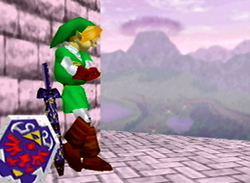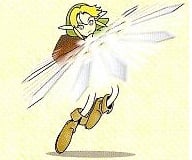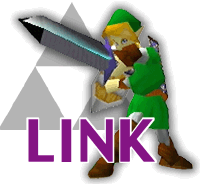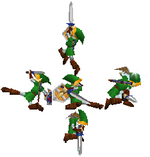Link (SSB)
| Link in Super Smash Bros. | |
|---|---|
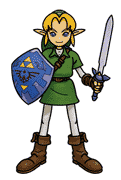 
| |
| Universe | The Legend of Zelda |
| Other playable appearances | in Melee in Brawl in SSB4 in Ultimate |
| Availability | Starter |
| Tier | C (11) (North America) ? (9) (Japan) |
| “ | Link is the young fighter who protects the peace in the world of Hyrule. His skills with the sword are both varied and powerful. | ” |
| —Super Smash Bros's instruction manual | ||
Link (リンク, Link) appears as a starter character in Super Smash Bros. He is the sole representative of The Legend of Zelda series. Link is perhaps the most well-equipped character with either long ranged and melee options of attack, with two projectiles (which would become three in later iterations), his long-reaching Master Sword and his Hookshot. His design is based on his appearance as an adult in The Legend of Zelda: Ocarina of Time. He is voiced by Nobuyuki Hiyama, who also voiced him in Ocarina of Time, with his voice recycled from the game.
Link is currently ranked 11th on the tier list, the second lowest ranked character, outranking only Luigi. Link is known in high level competitive play as a very defensive character, relying on bombs and Boomerangs to prevent gimps and using his up tilt and up and back aerials for combos, while using his forward and down smash, down aerial, and projectiles for edgeguarding. Having many disjointed melee attacks and his aforementioned two projectiles, Link can be a hassle to approach, while also having an average approach himself courtesy of his extremely high traction.
However, his lack of speed and maneuverability cause problems for Link in approaching the opponent. In fact, much of Link's strategy consists of standing back, throwing projectiles, and waiting for an opening. Due to his slow ground movement and attacks, it is imperative for Link players to be able to not only short hop but be able to input an attack immediately afterward. Link's recovery is awful, making offstage play very risky. He is also very easy to combo due to his weight and being a fast faller. Link's recovery and combo vulnerability make many of his matchups difficult. Link is slightly better in the PAL version due to having faster air speed (improving his recovery and some of his combo ability), and his forward smash dealing 4% more damage, and much better in the Japanese version where he is ranked 9th on the tier list, due to Link's up tilt having more reliable combo ability and sending opponents on a more favorable angle to combo, as well as his bombs being much easier to use in combos. Regardless, he has poor matchups on the NTSC version, and poor results due to his low playerbase.
Attributes
In general, Link's attacks are slow, long-ranged, and powerful. This gives him good KOing ability, with his down aerial and forward smash being especially powerful finishers. However, his moves are laggy and easy to punish if they aren't landed. His grab is also ranged, being one of the three tether grabs in the game, but it is also very slow and leaves Link very vulnerable if it misses. Link himself is also rather slow, with the second lowest dashing speed in the game and very short jumps. Despite this, his air speed and walking speed are above average. Link is also very stable in terms of gameplay.
Link has some powerful finishers as well. His forward tilt is among the strongest, but also slow for one. His forward smash is powerful but slow for a forward smash. Spin Attack is a powerful move both on the ground and the air.
Link is known for relying on his two projectiles (his Boomerang and bomb) to keep his opponents away and prevent them from approaching. His projectiles can which can lead to some combos. They can also be used to edgeguard. However, while Link can camp well himself, he has trouble dealing with projectile camping from some characters (especially Fox), due to his poor mobility and jumps.
Link is also heavy, which means he is harder to KO than normal, but it along with his size also makes him easier to combo. Link has some combo moves himself, including his up tilt, back aerial, and up aerial, as well as his aforementioned projectiles. His down aerial, forward smash, down smash, and projectiles are his main edgeguarding moves. He is one of the only two characters in the game (along with Pikachu) to not have a meteor smash, which can give him some minor trouble edgeguarding.
Link's biggest problem is his recovery, which is possibly the worst in the game, and one of the worst in the series. His very short jumps, fast falling speed (the second fastest in the game) and extremely poor distance given by Spin Attack (it even descends before the animation is over), with no options to extend it. Link is also edgeguarded and gimped easily.
Link is low on the tier list because he is very easy to combo and edgeguard, which allows many characters to get him offstage quickly and finish him off, if not zero-deathing him outright. Link relies solely on his projectile camping to avoid this. Link is not helped by the fact that Dream Land is the only legal stage in competitive play. When Hyrule Castle was legal, he could rely on projectile camping there far more than on Dream Land.
Differences between game versions
Japan to NTSC
Link was severely nerfed in his transition to NTSC. Many of his combo starters were toned down or removed and his recovery is even worse, while his moves deal less damage. While the higher SDI presence makes it easier for him to escape combos, this doesn't really have an effect due to how easy he still is to combo. This makes him worse than in the Japanese version.
Aesthetics
 The reflective metal visuals on Link's Master Sword have been removed, making his sword look more plastic and cartoonish.
The reflective metal visuals on Link's Master Sword have been removed, making his sword look more plastic and cartoonish.
Attributes
 Link's Master Sword is slightly shorter, worsening his range.
Link's Master Sword is slightly shorter, worsening his range. Link walks slightly slower (0.4 → 0.37).
Link walks slightly slower (0.4 → 0.37). Link's jumps are shorter due to his higher gravity (3.2 → 3.4).
Link's jumps are shorter due to his higher gravity (3.2 → 3.4). Link's shield size is slightly larger (260 → 280).
Link's shield size is slightly larger (260 → 280).
Ground attacks
 Up tilt deals 5% less damage (15% → 10%), making it much more punishable when shielded, and sends on a more horizontal angle, removing its ability to combo into itself at low percents for easy combos.
Up tilt deals 5% less damage (15% → 10%), making it much more punishable when shielded, and sends on a more horizontal angle, removing its ability to combo into itself at low percents for easy combos. Up smash deals 2% less damage (24% → 22%).
Up smash deals 2% less damage (24% → 22%).
Aerial attacks
 Neutral aerial has more knockback and sends on a more diagonal angle.
Neutral aerial has more knockback and sends on a more diagonal angle. Some of forward aerial's hitboxes deal 1% less damage.
Some of forward aerial's hitboxes deal 1% less damage. Back aerial's first hit comes out 1 frame slower. The second hit has a more diagonal angle.
Back aerial's first hit comes out 1 frame slower. The second hit has a more diagonal angle. Down aerial deals 2% less damage (18% → 16%).
Down aerial deals 2% less damage (18% → 16%).
Special attacks
 Boomerang covers less distance and only causes opponents to tumble past 100%, removing most of its usefulness in combos.
Boomerang covers less distance and only causes opponents to tumble past 100%, removing most of its usefulness in combos. Spin Attack deals 1% less damage in spots and covers less distance in the air, worsening his recovery.
Spin Attack deals 1% less damage in spots and covers less distance in the air, worsening his recovery. Bombs deal 1% less damage when thrown down and 2% less when thrown any other way.
Bombs deal 1% less damage when thrown down and 2% less when thrown any other way. Bombs has more knockback at any percent which makes comboing easier.
Bombs has more knockback at any percent which makes comboing easier.
NTSC to PAL
Link got some small buffs in the transition to PAL. His higher air speed improves his recovery and his forward smash is a better finisher due to its higher damage. His higher weight increases his survivability but also makes him even more the vulnerable to combos. Ultimately, Link did not get significantly improved in the PAL version.
Attributes
 Link is heavier (0.96 → 0.9).
Link is heavier (0.96 → 0.9). Link has higher air speed (31 → 37).
Link has higher air speed (31 → 37).
Ground attacks
 Forward smash deals 4% more damage.
Forward smash deals 4% more damage.
Moveset
| Name | Damage | Description | ||
|---|---|---|---|---|
| Neutral attack | 5% | A vertical slash, a horizontal slash, and a stab. If the attack is button mashed, the third hit will be replaced by a series of rapid jabs that can angle diagonally upwards, straight, and diagonally downwards. | ||
| 3% | ||||
| 4% | ||||
| 1% per jab | ||||
| Forward tilt | 17% (hilt), 18% (blade) | A delayed downward swing. Somewhat slow but above average damage and knockback for a forward tilt. | ||
| Up tilt | 10% | Quickly swings the Master Sword in a small arc above him. Can be chained together and good for leading into combos, usually forward tilt or neutral aerial. The attack's trajectory is based on where they are positioned on hit; when facing right, there's a slight right angle, and vice versa. This move can usually KO a foe reliably above very high damages such as 200%. Changes heavily in Japanese version of Smash 64, doing 14% damage and being able to shield break and a better angle for combos. | ||
| Down tilt | 12% | A ground-level slash. Usually knocks foes upwards. At lower percentages, this can be followed by a forward smash, a forward tilt, or even a grab. At high percents, it loses combo potential due to sending opponents too far for a follow-up. | ||
| Dash attack | 16% (clean body), 11% (late body), 14% (clean blade), 10% (late blade) | Comes to a stop mid-dash, stabbing in front of himself. Good range and speed, and can KO usually around 150%. Great for combo finishers. Moderate ending lag. | ||
| Forward smash | 12% (tip), 20% (non-tip) | Twirls his sword twice in hand, then slashes downward in a similar fashion to his forward tilt, but with more power and lag. Much stronger if hit with the main blade, with very good knockback. | ||
| Up smash | 22% if all hits connect | Three quick, narrow slashes while looking upwards. Lacks range but good for damage racking, as long as the foe doesn't DI out of it. Best suited for heavier characters. This move is somewhat weak for KOing, but at lower percentages it can lead into itself, an aerial, or Spin Attack. In most other cases, an up aerial or simply some other juggling plan (usually a Bomb readied before the move) is recommended. | ||
| Down smash | 16% | Swiftly slashes in front of himself, then behind. A good close-range defensive move but also effective for KOing. This move is one of Link's few moves that come out near-instantaneously, and the ending lag is also rather low. Assuming Link is facing right, when the foe is hit on either side while being closest to Link, they will be sent upwards at a slightly angled trajectory. When hit at the end of Link's blade, it'll knock the foe in a 45° angle in the direction depending on what side they were hit on. | ||
| Neutral aerial | 10% (clean), 8% (late) | An aerial sex kick. Best used as a defensive move due to its speed and lack of KO power. Moderately good combo move, and effective for edge-guarding. | ||
| Forward aerial | 20% (clean), 12% (late) | Does a swirling slash in a complete circle. Has two hitboxes: the early hit does 20% damage with a good amount of knockback, while a late hit deals less damage, but keeps its decent strength. It is not possible that the two hits will combine into each other. It is used competitively to end combos due to its knockback. | ||
| Back aerial | 20% if both hits connect | Two kicks behind himself. They combo into each other for a good amount of knockback, though the second hit can be DI'd out of. In addition, it is risky to use this move near a ledge due to the length of this move, as Link's recovery may not always be good enough to make it back to the stage. Very useful for combos. | ||
| Up aerial | 16% | Stabs upward, similarly to his Up Thrust from Zelda II: The Adventure of Link. Decent KO power, can also juggle. Link's blade carries the move's hitbox. Useful on platforms to extend combos. | ||
| Down aerial | 16% | Aims his sword directly below him for a long duration, similarly to his Down Thrust from Zelda II: The Adventure of Link. This has great horizontal knockback. It is possible to hit the same enemy twice to have this move inflict 32% altogether. This move can be used to KO recovering foes by jumping directly at them, but this is only safe if the bounce of the connected hit allows Link to return to the stage. It should be noted that this move's downwards descent can be hastened by fast falling, although doing so is unwise near ledges. Has substantial landing lag when the player lands on the ground while using the move if not Z-cancelled. Usually considered to be Link's best aerial for shield pressure when Z-cancelled. Used competitively to end combos due to its knockback. Along with Pikachu's, this is the only down aerial in SSB to lack a meteor smash hitbox. | ||
| Grab | Hookshot | — | Uses the Hookshot while standing. Link, along with Samus and Yoshi, has an "extended grab". This allows him to grab opponents from a distance, but the grab is very laggy if it misses. This can lead to various unique combos due to Link's high grab range. | |
| Forward throw | 14% (throw), 8% (collateral) | Kicks his foe forward with good power. Often throws the foe far enough to set up a quick boomerang or bomb-based edgeguard, or simply one of Link's aerials. | ||
| Back throw | 16% (throw), 8% (collateral) | Takes the foe and kicks them directly behind him. Somewhat better KO power than his forward throw. | ||
| Floor attack (front) | 6% | Slashes on both sides and gets up. | ||
| Floor attack (back) | 6% | Slashes on both sides and gets up. | ||
| Edge attack (fast) | 4% | Flips over and slashes outwards. Decent range. | ||
| Edge attack (slow) | 4% | Slowly picks himself up and stabs at a slight upward angle. | ||
| Neutral special | Boomerang | 9% (throw), 8% (return) | Throws a blue boomerang, which returns after a set distance. One of Link's two projectiles. Doing a "smash throw" (smash the Control Stick forward while pressing B; similar to performing a smash attack) increases the distance the boomerang can travel. The Control Stick can be tilted up or down to aim the boomerang's trajectory. Can edgeguard, and can be used during combos if Link is a distance away from the opponent, as the hitstun caused by it allows Link to continue his combo. | |
| Up special | Spin Attack | Ground: 21% if both hits connect (clean), 13% if both hits connect (late) Air: 16% (clean), 8% (late) | Performs his signature Spin Attack. A powerful attack, especially on the ground; when grounded, the spin creates a wide, orange magic circle that grants the move more range. However, it is generally terrible for recovery, as it covers a very short distance; this gives Link a predictable recovery, and is often cited as the main reason why he is in bottom tier, as he is very easily edgeguarded by most characters, especially Pikachu and Kirby. | |
| Down special | Bomb | 5-17% (see here for full details) | Pulls out a bomb, which functions as an item that explodes on contact with an opponent or after its fuse runs out. Link's second projectile. There are many techniques that can be performed with bombs, which can be read about here. Though difficult to time, the hitstun caused by the bomb allows Link to force himself out of helplessness to attempt recovering again. | |
On-screen appearance
- Descends from a column of light, similar to the end-of-dungeon teleports in Ocarina of Time, before unsheathing his sword as he hits the ground.
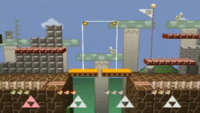
|
|---|
Taunt
- Raises his leg and sword hand in a "readying" stance. Appears similar to the pose Link performs before attacking in Zelda II: The Adventure of Link.
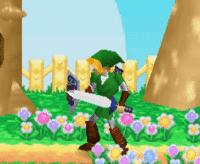
|
|---|
Crowd cheer
| English | Japanese | |
|---|---|---|
| Cheer | ||
| Description | Go Link! *claps 3 times* | Lin-k! |
| Pitch | Group chant | Group chant |
Victory poses
- Kneels while sheathing the Master Sword.
- Swings the Master Sword twice before him, before spinning and stopping with his back turned to the screen (also his character selection animation).
- Holds the Master Sword before his face, then hoists it upwards.
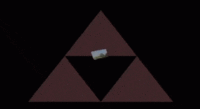 |
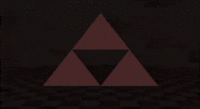 |
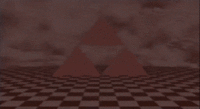
|
|---|
In Competitive play
Matchups
International versions
| Avg. | |||||||||||||
Originally, Link's matchup spread was one of the weaker ones in the game with only two winning matchups, three even matchups and the rest being losing matchups where Link is heavily countered. Link did well against characters with poor neutral, poor mobility and poor range. He did well against floaty characters that he had easy combos on and could lead into early kills with. This is the reason why he has winning matchups against Samus and Luigi, due to their low mobility, range and having trouble getting in. He would have even matchups with characters who he could keep out, but once opened up, he would struggle to keep them out again, but not by much. However, his worst matchups are due to his slow mobility, sluggish frame data, over reliance on projectiles, his vunberbility to combos due to being a heavyweight and a fast faller, and having one of the worst recoveries in the game. His sluggish movement and frame data would lead to him being opened up by characters with an insane combo game on fast fallers, such as Kirby, Pikachu, Falcon and Yoshi. He would be overwhelmed by characters with great mobility, such as Fox, Pikachu and Falcon. He would be easily edge guarded by Pikachu and Kirby, or any character who can send him far away from the stage. This would lead to Link having a below average matchup spread. One of the main reasons his matchups weakened over time was due to him no longer being able to projectile camp on Hyrule Castle, due to the stage being banned and being forced to fight on a smaller stage.
However, in the current metagame, Link's matchups, while still bad, has changed. Link's matchup against Kirby, one of his worst matchups, is not seen as bad as it once was due Link having many options to keep Kirby out and convert into his KO options. His matchup with Mario isn't considered as bad due to him being able to keep Mario out and convert into KO options. Although his matchup with Jigglypuff, though still considered even by some, has become more into Jigglypuff's favor due to its strong edge guard game and having zero to death combos into Rest on all fast fallers. His matchup with Samus is being debated due to advances in Samus' metagame, with Samus doing better on Dream Land due to her platform movement and her combos in her strong KO options, that would knock Link to far away to recover. As of the current moment, Link's matchups outside of one still appear to be bad for him and it is unknown how many more matchups will change in the future.
Japanese version
| Avg. | |||||||||||||
Notable players
- See also: Category:Link professionals (SSB)
Numbers in brackets indicate position in 64 League Rankings 2017
DSC Ranked 5th in Australia in 2017.
Firo (#33) More known for his Ness.
Gyaki (#17) Best Link main in the world, placed 5th at Snosa III and 2nd at Kansai 2017.
Hebiichigo Japan's 3rd best Link.
Isai (#11) Placed 2nd at Apex 2012 and won FC Diamond (2007) and B.E.A.S.T 7 (2017) with Link.
Kort (#35) More known for his Pikachu.
Sekirei Japan's 2nd best Link.
Inactive
A$ 3rd at Zenith 2013
Tier placement and history
Throughout the history of Smash 64, Link has always been regarded as one of the worst characters in the game. On the first tier list for 64, he was dead last in bottom tier, sharing it with Samus. He rose up to 11th on the second tier list then he would remain, but share the same placement of 10th-11th with Luigi on the third list. He would regain the placement of 11th tier on the fourth and most current tier list where remains the second worst character in the game.
However, in spite of his placement, Link has achieved high results in a few tournaments due to the performance of players such as Isai, Gyaki and Sekirei. Even with these high placements by top players, it unknown if Link will ever get out of the bottom two spots that he has always been in throughout the game's life span.
In Single-player
- In the game's single-player mode, Link is the first character the player battles; he is faced on Hyrule Castle.
- If the player is against Link in Single Player Mode on Very Easy, he will not attack or move until the player makes the first few strikes or after a period of time.
Techniques
Extended Boomerang
Link's boomerang (neutral special attack) goes farther if it is treated as a smash attack. Quickly tap the control stick to the side while hitting B to extend the range.
Extended boomerang ledge boost
Link's extended boomerang, if used at the right distance from a ledge to allow Link to maintain momentum after dashing, results in Link going significantly further in midair during the boomerang throw animation. This is useful when performing a combo on an opponent who is slightly too far for the boomerang to hit.
Bomb gift
Lightly throwing a bomb so that it lands on a platform near a spawning opponent is a popular mindgame as the latter will often be tempted to pick the bomb up. This results in the player losing the invincibility frames granted by the spawn.
Invisibomb glitch
Link pulls out a bomb and places the bomb on the ground without having it explode. When the bomb will near the explosion point while being out of explosion range, Link will have just a few frames to grab the bomb (now invisible) after the explosion. All bombs thrown by Link will become invisible.
Off ledge Spin Attack
Performing a grounded Spin Attack right after Link's initial dash while running off a ledge will result in Link continuing his spin attack in midair without the animation changing to his aerial spin attack. This rarely has any uses outside top Link players using it to edgeguard or complete combos.
Bomb recovery
Like Samus, Link can use his bombs to aid his recovery. However, unlike Samus, Link must use a bit of technical skill and timing. While recovering, one should pull out a bomb and drop it slowly below Link, then continue to DI towards the stage, and use a back aerial. This will cause Link to explode toward the platform. One should then use his Up B and land back safely. Note that Link will not be able to grab the edge because the explosion causes him to face the other direction. To counter this, one must throw his boomerang before using his Up B. This technique is extremely situational and difficult to perform. Despite the difficulty of pulling off the technique, it does not greatly help Link's recovery.
Black-cat setup
A technique popularized by Kort involving a set up of positioning a bomb for a boomerang hit as an edgeguarding technique. The technique requires Link to throw a bomb on stage opposite to where the enemy is (preferably when the enemy is offstage), followed by a toss of a boomerang against the bomb, causing the boomerang to 1) ricochet flying in the opposite direction towards the enemy, 2) accelerate at a faster speed then the previous speed then initially thrown, and finally 3) will go through Link without causing Link to catch the boomerang, allowing for Link to reduce lag caused by the grab of a returning boomerang.[1]
Description
From the Game
Link is the valiant boy hero of "Legend of Zelda" series in which he fights against the evil Ganon to recover the Triforce. Though his tools may change with each adventure, his strength and righteousness remain constant. With his trusty sword and a variety of weapons, he takes his adventures head on!
Works:
- The Legend of Zelda (NES)
- The Legend of Zelda: A Link to the Past (SNES)
- The Legend of Zelda: Ocarina of Time (N64)
Alternate costumes

| |||
Trivia
- Link is one of the two characters to lack a meteor smash, the other being Pikachu.
- When Link picks up a battering item, his dash attack will show him using his sword and the item he's wielding.
- In the PAL version of Smash 64, Link is the second heaviest character and no longer shares his weight with Captain Falcon.
- On the Character selection screen, Link's portrait greatly resembles his artwork from The Legend of Zelda: Ocarina of Time.
References
| Fighters in Super Smash Bros. | |
|---|---|
| Fighters | Captain Falcon · Donkey Kong · Fox · Jigglypuff · Kirby · Link · Luigi · Mario · Ness · Pikachu · Samus · Yoshi |
